The Southern Hemisphere is currently in its Winter season, and dynamic weather patterns will initiate a strong warming event in the Stratosphere above the South Pole. These events are rare in the Southern Hemisphere but powerful and are known to have an effect on the entire globe.
These stratospheric warming events pack a lot of energy and can affect the entire hemisphere. We have had several cases where that happened in the Northern Hemisphere, affecting the winter weather patterns.
The Southern Hemisphere does not experience these winter stratospheric warming events so often, with only a few known events in the past decades. We will look at the current stratospheric warming event unfolding and some of the unusual effects it can have on the Northern Hemisphere.

POLAR VORTEX CIRCULATION
The driving force behind these events is the Polar Vortex. To understand what it, its usually the best to visualize it. In simple terms, it is just a name that describes the broad winter circulation over the northern (and southern) hemispheres.
Below, you can see a 3-dimensional image of the polar vortex. The vertical scale is greatly enhanced for better visual presentation. It nicely shows the otherwise hidden structure of the polar vortex, connecting down to the lower levels, the pressure systems, and the winter weather patterns.
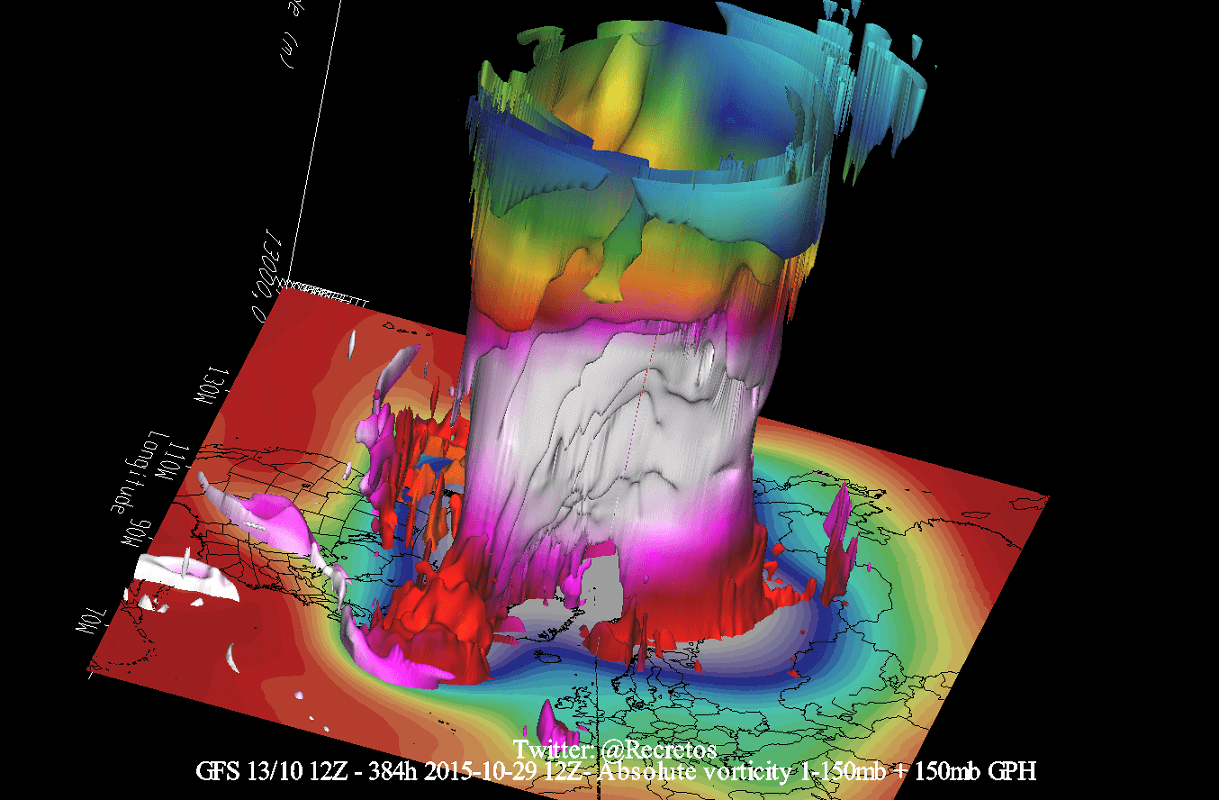
The Polar Vortex extends high into the atmosphere. The lowest level is called the troposphere, where all weather events occur. But above that, we have the Stratosphere, a deeper and drier layer that is home to the ozone layer.
Overall, the Polar Vortex behaves like a very large cyclone, covering the whole north pole down to the mid-latitudes. It is connected through all atmospheric levels, from the ground up, but can have different shapes at different altitudes.
For this reason, we separate the entire Polar Vortex into an upper (stratospheric) and a lower (tropospheric) part. They both play their role differently, so we monitor them as two separate systems, but how they are connected is also very important. Image by NOAA-Climate.

The upper (stratospheric) part is more circular and symmetrical as it spins higher above the ground, with fewer obstacles in its flow.
But, the lower structure of the Polar Vortex is much more uneven and regularly disrupted. That is due to the influence of the terrain/mountains and strong pressure systems acting as obstacles.
Below is an image showing the polar vortex at different altitudes. The closer to the ground we get (left side), the more deformed it becomes due to the complex terrain and the many weather fronts and systems deforming it.

The process is exactly the same in the Southern Hemisphere. But there is much less terrain in the Southern Hemisphere, so there are fewer disruptions of the stratospheric Polar Vortex.
To put the Polar Vortex into perspective, we produced a high-resolution video below, showing the Vortex spinning over the Northern Hemisphere in the Stratosphere at the 30mb level, around 23km/14miles altitude.
The video mainly shows that the Polar Vortex is not just one winter storm or a cold outbreak that moves from the Midwest into the northeastern United States. It is a powerful large-scale circulation.
We must monitor the state of the Polar Vortex, as it can have a profound impact on our daily weather. We mainly separate the Polar Vortex into two different modes:
A strong/stable Polar Vortex usually means strong polar circulation and jet stream. This contains the colder air into the Arctic Circle, creating milder conditions for most of the United States.
In contrast, a weak/disrupted Polar Vortex creates a weak jet stream pattern. As a result, it has a harder time containing the cold air, which can now escape from the polar regions into the United States. Image by NOAA.
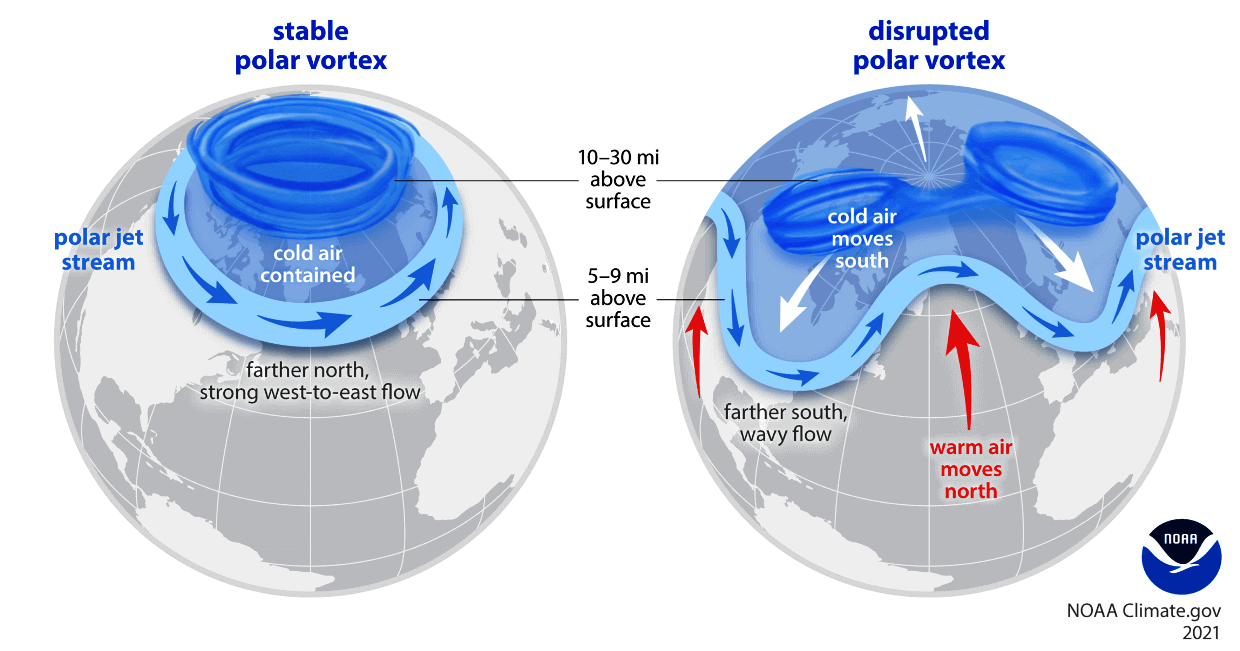
So a weak Polar Vortex creates a more disrupted weather pattern, regardless of which hemisphere we are talking about.
That is usually achieved by increasing the pressure or temperature in the polar Stratosphere. We call such events “Sudden Stratospheric Warming,” as the name suggests, a rapid temperature increase in the Stratosphere.
In this article, we will analyze a currently ongoing Stratospheric Warming event over the Southern Hemisphere. The event itself happens exactly the same way as over the Northern Hemisphere.
STRATOSPHERIC WARMING EVENT
Usually, we look at the polar vortex in the stratosphere at the 10mb level. That is around 28-32km (17-20 miles) altitude. This altitude is considered to be in the middle stratosphere and serves as a good representation of the general dynamics of the polar vortex.
The strength of the polar vortex is usually measured by the power of the winds inside and around it. This is done by measuring the zonal (west-to-east moving) wind speeds around the polar circle (60° latitude).
Below is an analysis from the NASA monitoring system. It shows the stratospheric jet stream over the North Hemisphere in winter 2020/2021, which reversed into negative values in early January (red line).

This was a breakdown/collapse event of the stratospheric Polar Vortex, initiated by a very strong Sudden Stratospheric Warming event.
The date of the Sudden Stratospheric Warming event was marked on January 5th, as the winds around the polar circle reversed. The stratospheric warming wave has crawled over the entire North Pole in the stratosphere, effectively splitting the cold core of the polar vortex into two parts.
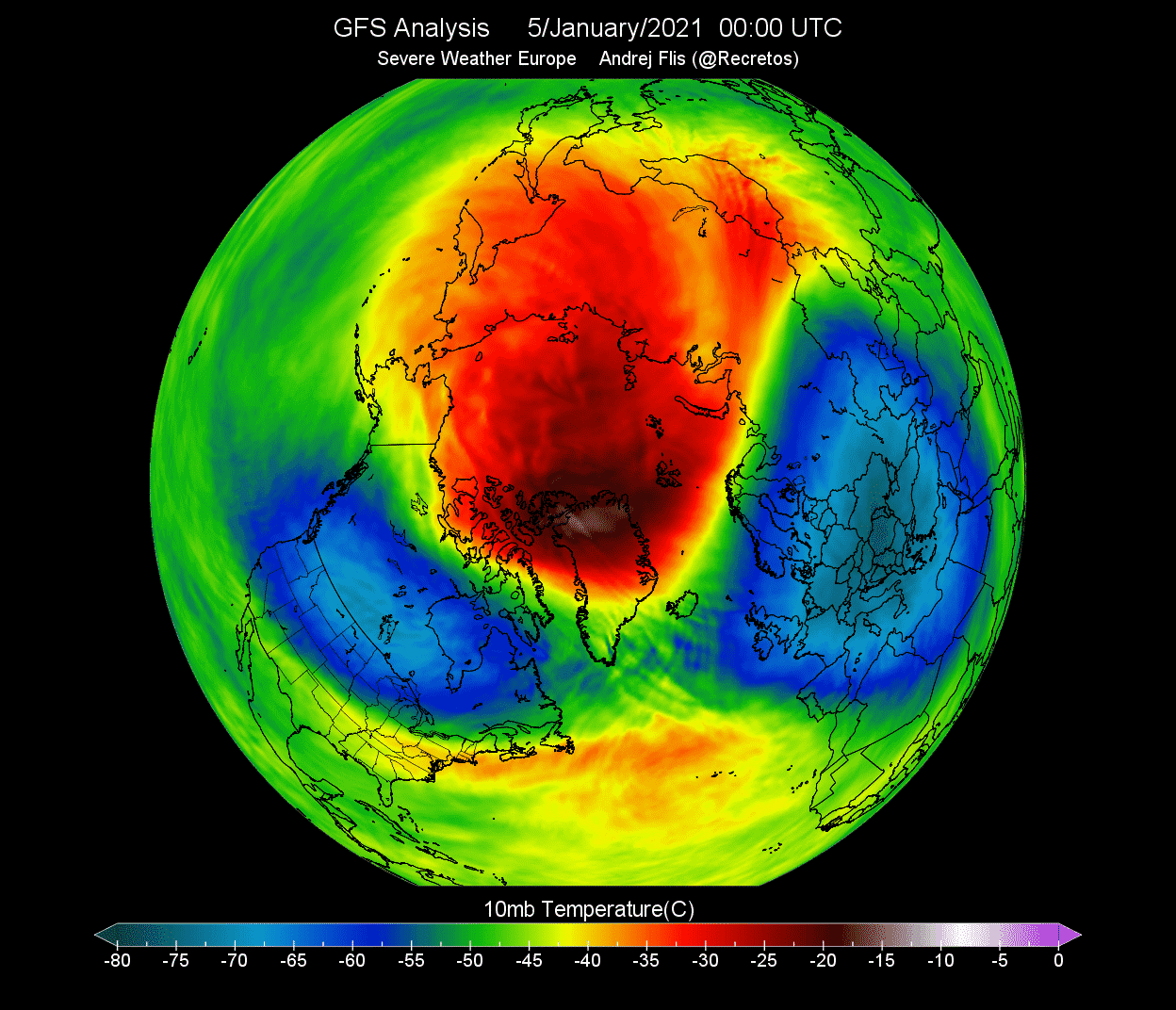
One part of the broken polar vortex has moved over North America and one over the European sector. At this point, this did not have a direct impact on the winter weather on the surface, as this is at a 30km altitude. But the Polar Vortex was collapsing like a house of cards at this point, with effects eventually reaching the ground.
The next image below shows an atmospheric pressure index. Negative values indicate lower pressure (blue colors), and positive values indicate higher pressure (red colors). We have altitude from the ground up to the top of the stratosphere (~46km), covering Winter 2020/2021 and early Spring 2021.

Strong positive values were seen in the stratosphere in early January, associated with high pressure buildup during the stratospheric warming event. The event and its influence slowly descended over time, reaching lower levels by mid- and late January.
This persisted well into February, influencing the weather circulation even when the stratospheric warming was already over at the higher levels. So you can see just how big of an impact such an event can have on the weather patterns.
The event above unfolded over the Northern Hemisphere, but the dynamics are exactly the same over the Southern Hemisphere. Of course, the direct initial impacts are limited to the Southern Hemisphere, but as you will see later, it can extend its effects into the Northern Hemisphere.
SOUTH POLAR STRATOSPHERIC WARMING
The Southern Hemisphere has opposite weather seasons to the Northern Hemisphere. So, while we are going towards late Summer, there is still Winter in the Southern Hemisphere, meaning it has an active Polar Vortex circulation.
Below is a special image from NASA. It shows the temperatures in the core of the south stratospheric Polar Vortex around 30km/18miles altitude (10mb level). The violet line shows a strong peak of southern polar temperatures in the stratosphere, rising into the highest ever for this time of year.
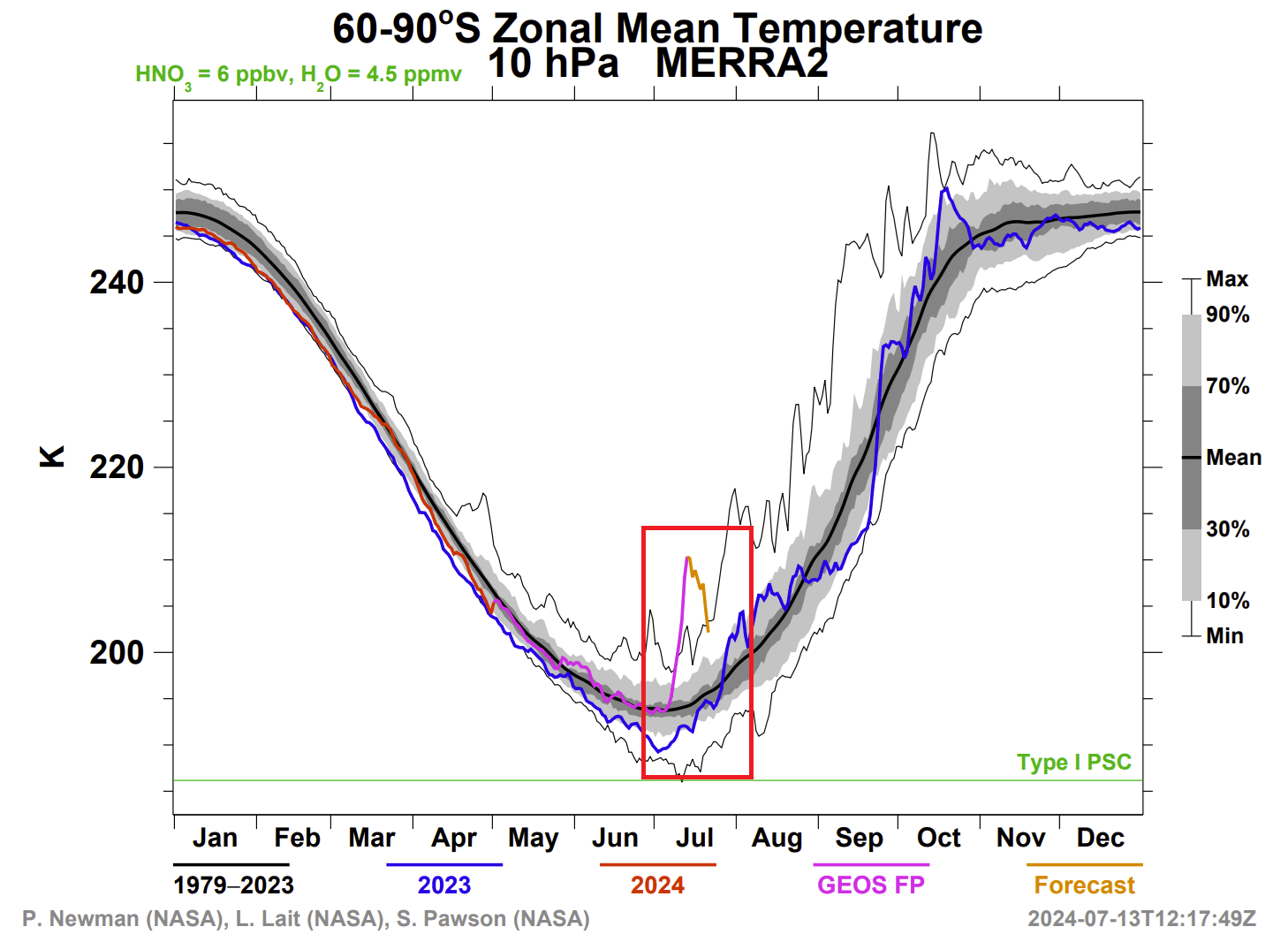
So, how is this event unfolding? In the image below, you can see the latest temperature analysis of the stratosphere over the south pole. A very strong warming wave is pressing against the core of the southern polar vortex, expanding deeply into the polar circle.

Below is the current pressure anomaly in the stratosphere over the south pole. You can see the polar vortex and a strong high-pressure anomaly developing, pushing against the polar vortex from the same side as the warming wave.

The temperature anomaly analysis also shows a strong temperature anomaly at this level (10mb ~ 30km/18miles). This area of strong above-normal temperatures is the stratospheric warming event, with peak temperatures over 60°C above the long-term average.

Looking at the wind and temperature forecast for this level of the stratosphere, you can see the winds reducing as the polar vortex is under pressure. Also, you can see a strong peak in temperatures as the stratospheric warming event develops to its maximum anomaly.

Looking at the pressure anomaly forecast on day 5, you can see there will be two pressure anomalies in the stratosphere, pressing onto the polar vortex from two sides.

Along with the high pressure come two warming waves. Remember, this is unfolding in the stratosphere. The anomalies show how unusually high temperatures in the stratosphere disrupt the polar vortex and the circulation over the southern hemisphere.
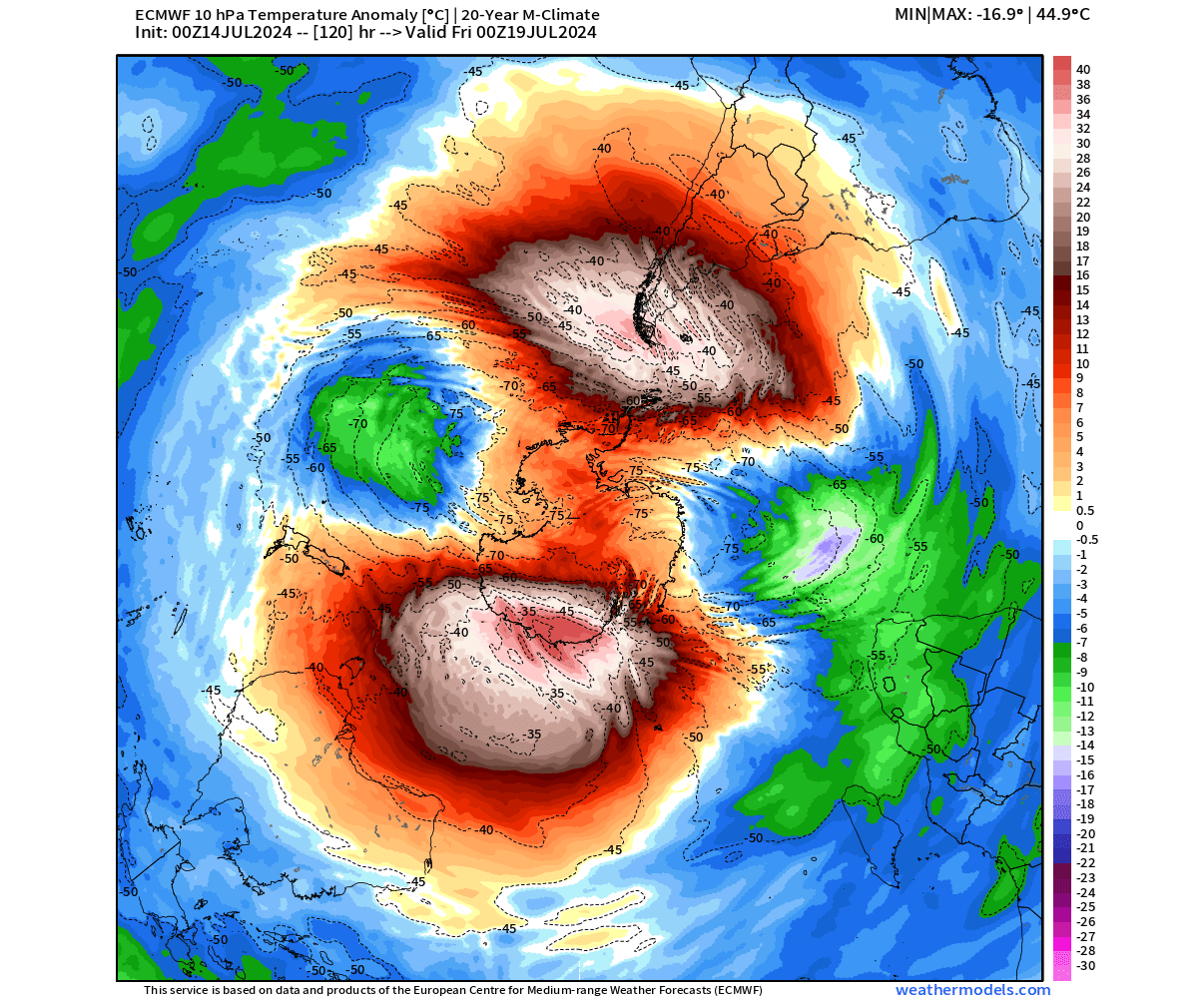
In the image below, you can see the atmosphere by altitude, and the colors indicate pressure anomalies over the south pole. We can see a high-pressure anomaly in the stratosphere, connecting down in the forecast part. The anomaly in the stratosphere is the current stratospheric warming event, which is forecast to send a high-pressure wave downwards.

Looking below at the pressure patterns for the medium range, you can see a high-pressure anomaly over the south pole, and the displaced low-pressure areas towards southern Australia and South America. This indicates a disruption in the circulation, likely connected with the developing pressure anomalies in the stratosphere.

Below is the ECMWF extended ensemble forecast for late July and early August. This forecast shows the temperature anomaly in the southern stratosphere. As you can see, the stratospheric warming anomaly will continue into next month, but likely with reduced strength.
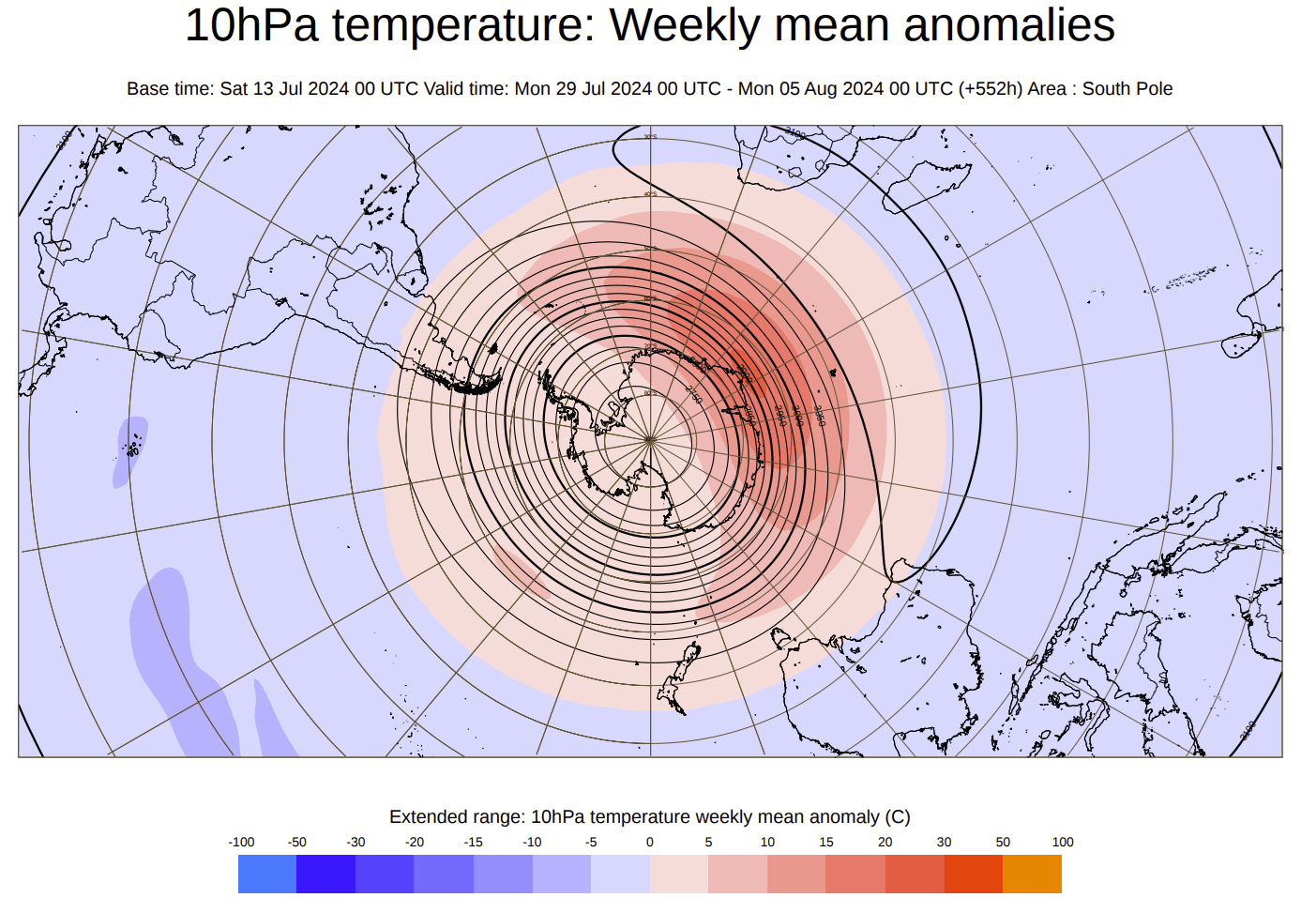
Overall, this is a pretty significant stratospheric warming event over the southern hemisphere.
GLOBAL WEATHER REACH
If you live in the Northern Hemisphere, why would you care about a stratospheric warming event over the South Pole? If you look at the image below, you can see a simple schematic of the global air circulation between the hemispheres. There is much more flow and dynamics in the Winter hemisphere, while the Summer hemisphere is calmer generally.

This is called the “Brewer-Dobson circulation“, and connects the circulation from both Hemispheres higher up in the atmosphere. In reality, it is far more complex, but this simple schematic shows the main idea of airflow and energy transfers.
This basically shows that both the northern and southern stratosphere are connected.
Below are interesting graphics from a study made about the stratospheric warming event in 2019 over the South Pole. The graphics show the change in Total Electron Content (TEC) in the Ionosphere over the United States and Europe.
The first image shows the Ionospheric anomaly over the United States following the strong stratospheric warming event over the South Pole. Strong 40-80% anomalies in electron charge were observed in the ionosphere over the United States.

The same but reversed change was observed over Europe, as the energy wave from the strong Stratospheric warming event had already reached the Northern Hemisphere.

Overall, this study found both positive and negative disturbances in the thermospheric Oxygen/Nitrogen ratio and total electron content over the United States and Europe.
These factors play a role in the geomagnetic activity of the Earth’s atmosphere, and the changes were strong enough to be detected and measured.
Direct weather changes were observed following this strong event in the higher and lower atmospheres. Signs have also emerged that the event was strong enough to have a weather effect on the following Winter 2019/2020 in the Northern Hemisphere.
It is not easy to track these changes and impacts, as much is lost in the global weather circulation. But in the image below, you can see a simple connection between the south pole pressure anomalies from August to October and the following temperatures over the Northern Hemisphere in December to February.

This graphic shows a signal between prolonged high-pressure anomalies over the South Pole in the August-October period and colder temperatures over the United States the following December-February.
There is a large caveat here: This correlation does not mean that the high-pressure anomaly over the South Pole is directly responsible for the lower temperature signal over the United States the following winter. It just indicates some connection but doesn’t explain what exactly it is.
It is possible that a large-scale event like Stratospheric Warming can cause a prolonged high-pressure anomaly over the South Pole. With several weeks to months of time, some effects of the SSW event could perhaps manifest in the Northern Hemisphere.
Learn more: Stratospheric Warming Event in January 2024
We will keep you updated on the global weather pattern development, so bookmark our page. Also, if you have seen this article in the Google App (Discover) feed, click the like button (♥) there to see more of our forecasts and our latest articles on weather and nature in general.